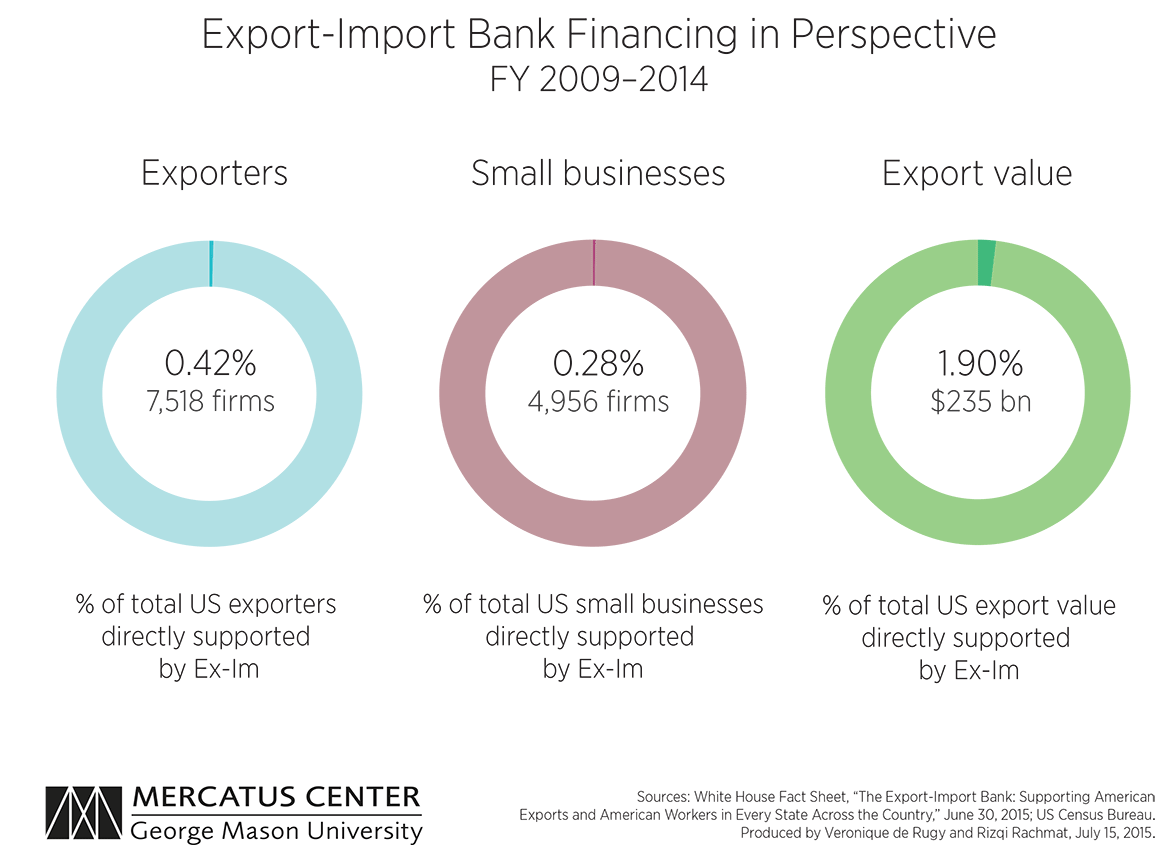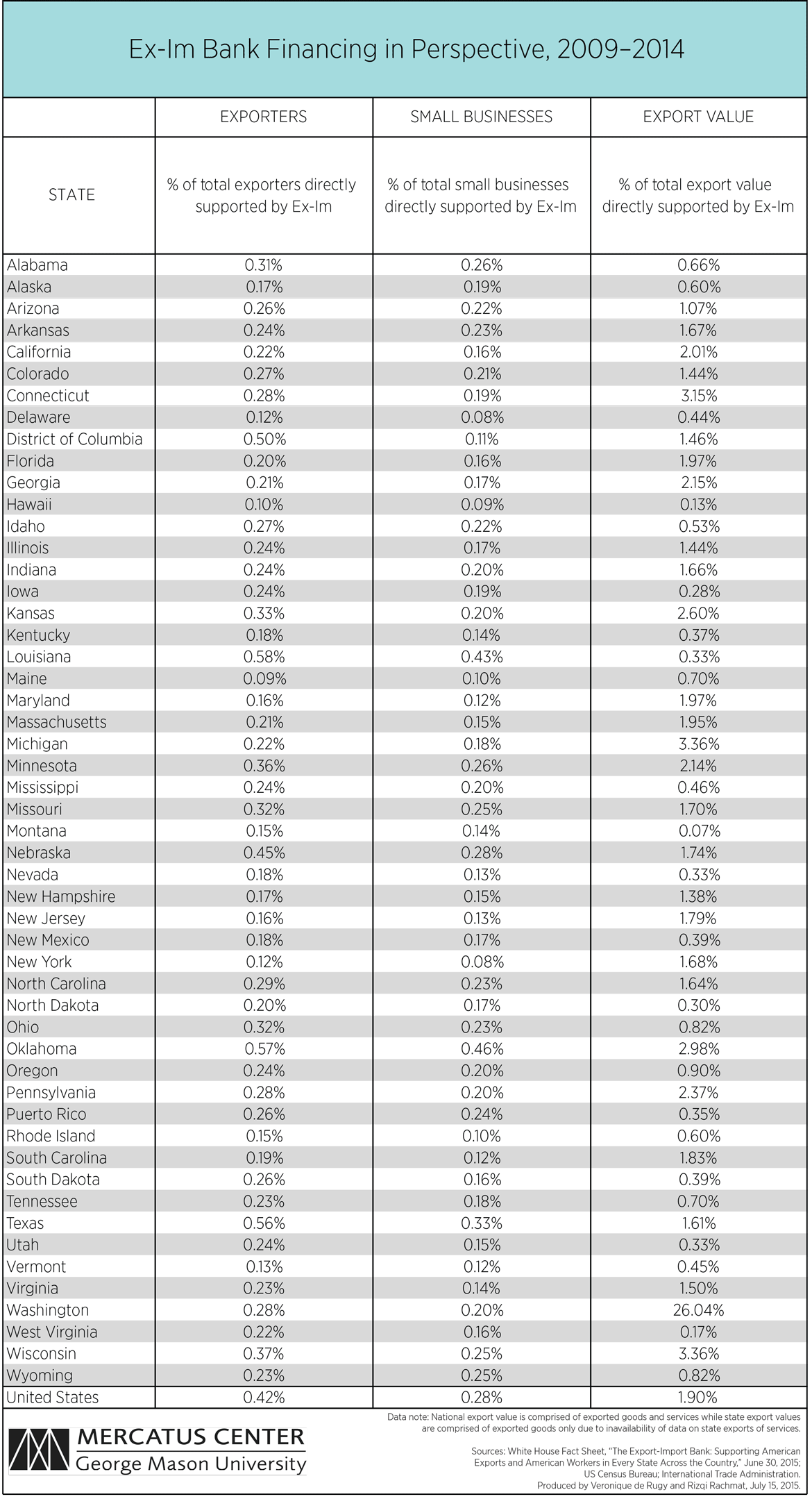- | Corporate Welfare Corporate Welfare
- | Data Visualizations Data Visualizations
- |
White House Confirms Negligible Impact of the Ex-Im Bank on Exports
To the put the Ex-Im Bank’s support of American businesses in perspective, we reproduced the White House table and replaced the nominal numbers with the share that each category represents. These shares show the impact of Ex-Im Bank financing on each state as a percentage of that state’s total exports but also small businesses and exporters over the same period.
On June 30, the White House stepped in to the fight to defend the record of the presently lapsed Export-Import Bank by releasing some data on the export value and the number of exporters and small businesses supported by the Ex-Im Bank for each state as well as for DC and Puerto Rico. In its release, the White House stated, “Over the last six years [2009–2014], Ex-Im has supported a total of $235 billion of exports from more than 7,500 businesses.” The White House also touts the oft-cited figure of 164,000 jobs supported by the Ex-Im Bank in 2014.
The White House figures, for the most part, do not match Ex-Im Bank’s own numbers. For instance, the White House reports an export value backed by the Ex-Im Bank of $235.4 billion between 2009 and 2014, whereas the Ex-Im Bank’s data report $217 billion for that same period, which is $18.4 billion lower than the White House figure. Also, in the state-by-state dataset, the White House claims more exporters supported by the Ex-Im Bank than the agency’s own dataset in 30 out of 52 cases. Arkansas and Nevada are the only two states for which the White House’s figures and Ex-Im Bank’s data match.
There is, however, one crucial place where the Ex-Im Bank figures and the White House data are consistent. They both show that the Ex-Im Bank supports a trivial share of exports, small businesses, and exporters in each state. Indeed, in the vast majority of cases, exporters sell their products overseas the good, old American way—without a government handout.
The first chart uses data from the White House dataset and the US Census Bureau’s US International Trade in Goods and Services Annual Revision for 2013 and 2014, their annual Profile of US Importing and Exporting Companies, and the International Trade Administration’s Jobs Supported by Export Destination Excel Data. It shows that in 2014, even with an inflated value of export value supported reported by the White House, the Ex-Im Bank backs only 1.9 percent of all exports. Also, the Ex-Im Bank backed a tiny 0.28 percent of all small business exporters and only supported 0.42 percent of all US exporters. Needless to say, without the Ex-Im Bank, American exports will not collapse.
The table below uses data from the White House and the US Census Bureau’s datasets on state exports, small and medium business exporters (up to 500 employers), and total exporters for 2009 to 2014. We also used data on export values from the International Trade Administration’s State Export Data tool. These datasets give an advantage to the White House since (1) some Ex-Im small business exporters can have up to 1,500 employers and 21.5 million in revenue and (2) the ITA data report on exported goods, not services.
To the put the Ex-Im Bank’s support of American businesses in perspective, we reproduced the White House table and replaced the nominal numbers with the share that each category represents. These shares show the impact of Ex-Im Bank financing on each state as a percentage of that state’s total exports but also small businesses and exporters over the same period.
During 2009 and 2014, Washington State was the big winner in terms of state export value supported, with an incredible 26.04 percent of state’s exports backed by the Ex-Im Bank. That should come as no surprise. Washington State is the home of Boeing, the bank’s main beneficiary in the United States. Not surprisingly either, the number of exporters supported by the agency was very small: 0.28 percent of exporters in Washington State were supported by Ex-Im.
The state percentages drop off quickly from there. While 3.36 percent of Michigan’s and Wisconsin’s exports and about 3.15 percent of Connecticut’s exports were backed by the Ex-Im Bank, the Ex-Im Bank supported less than 2 percent of the exports in most other states between 2009 and 2014. In other words, the Ex-Im Bank backs a negligible fraction of most state exports. A vast majority of exports in each state take place without any assistance from the government. But taxpayers in all states remain on the hook if the Ex-Im Bank runs into financial trouble.
As for the number of exporters supported by the Ex-Im Bank between 2009 and 2014, the numbers are even smaller. Louisiana was the big winner in terms of exporters supported, with a tiny 0.58 percent. All the other states, including Washington State, show an even smaller share of Ex-Im supported exporters.
The small business numbers show the same pattern. Oklahoma tops the list of small business exporters supported by the Ex-Im Bank with minuscule 0.46 percent.
In short, the White House’s effort to use its bully pulpit to save the Ex-Im Bank unwittingly confirms the negligible effect the agency has on the exports and exporters and further confirms that the sky will not fall if the bank is never reauthorized.



